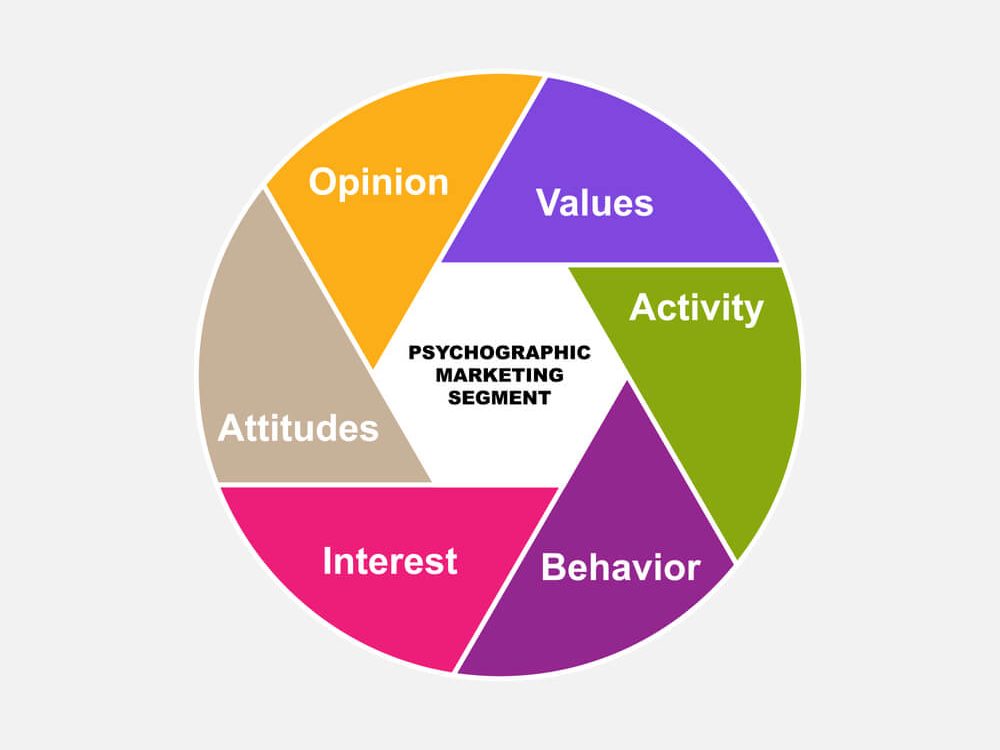Customers' perceptions, thoughts, and beliefs go a long way to inform their choices in the marketplace. To help you understand how these factors influence users' actions and leverage this data for your business, it is important to carry out psychographic segmentation.
Psychographic segmentation is widely considered as the most effective type of market segmentation because it serves as a gateway to consumers' thoughts. If you're looking to carry out psychographic segmentation for your target market, you should read this article till the end.
What is Psychographic Segmentation?
Psychographic segmentation is a type of market segmentation that pays attention to consumers' perceptions, thoughts, and beliefs and also utilizes this data to create customer segments. It is an important process that bridges the gap between consumers' psychological dispositions and your product.
This type of market segmentation can be traced to the VALS framework developed by Arnold Mitchell in 1980. The VALS model understudies the values, attitudes, and lifestyles of consumers, and leverages this data for market research. It is commonly referred to as the background of psychographic segmentation.
The dynamics informing psychographic segmentation are easy and relatable. As with everything else, you're more likely to make the right business decisions when you not only know who your customers are; but also have a fair idea of how they think.

In psychographic segmentation, you would encounter questions like:
- What motivates my customers?
- What principles do my users have?
- What are their inherent beliefs?
- What drives users to make conscious and/or unconscious decisions?
When you have the right answers to these questions, you become better equipped to predict consumers' behaviors and this results in more strategic marketing for your business. Psychographic segmentation, just like other types of market segmentation, helps you make objective marketing decisions.
Why Use Psychographic Segmentation?
Psychographic segmentation plays an important role in marketing as it helps you to emphasize the value of your product for different consumer categories. This makes your product multi-dimensional and as a result of this, you can attract different types of users and expand your customer base.
Top brands like Apple, utilize psychographic segmentation to create a brand personality that fits into the perception of their users. With psychographic data, Apple can communicate luxury, minimalism, and class to its target audience and also create marketing strategies for the different psychographic segments.
Examples of Psychographic Segmentation in Marketing
- Let's consider a jewelry brand that deals with customized accessories. First, jewelry is a luxury item that readily appeals to individuals in the upper class who have high purchasing power; that is, persons whose social class and income levels can afford such luxury.
To identify customers who need this product, you would need to carry out psychographic segmentation. Here, you'd identify different psychographic segments using variables like social status and purchasing power. With this, you'd be able to identify high-income customers who also belong to the upper class.

- Another example of psychographic segmentation in marketing can be drawn from an organization that makes plant-based processed food. This product primarily appeals to individuals who observe a particular lifestyle; that is, vegetarians or pescatarians.
Hence, you need to deploy psychographic segmentation to categorize consumers into different segments based on their lifestyle choices. Once this is done, you are better equipped to come up with different marketing campaigns for the relevant segments.
- Products like baby food and diapers also have a specific target audience; that is, families and new parents. These segments can be further categorized using consumer preferences and in line with the different uses of your product.
Psychographic Segmentation Variables
Psychographic variables are the factors that help you to identify and split your customers into different categories. Let's dive in and get familiar with a few of them.
- Personality: Personality traits play a big role when it comes to the choices of your target market. This is because consumers are less likely to purchase items that do not align with their personalities and vice versa. For example, an introverted person may not eagerly jump on a Friday night clubbing deal.
As an organization, you must consider customers’ personalities when creating marketing campaigns and targeted ads, as personality type also affects how customers perceive your advertisements. Common personality types in psychographic segmentation include creative, emotional, friendly, opinionated, introverted, and extroverted.
Understanding the personalities of your target audience also helps you create the right brand personality for your business and communicate this with your product. For instance, if your target audience primarily exudes the aura of being bold and in control, you can craft a product tag line that reflects this.
- Lifestyle: Customers also consider how your product fits into their lifestyle choices before making a purchasing decision. For example, creating a liquor variant of your product may not work well if your target market consists of individuals who do not take alcohol in any form.
Many fashion brands leverage lifestyle segmentation to boost sales, and this even reflects on the kind of makes they assign to clothing lines. For example, the "Digital Nomad" fashion line primarily appeals to young freelancers who prioritize their casual comfort as they work from home.
- Social Status: This is a very important variable in psychographic segmentation as every social class has its product preferences. This means that what people eat, wear or even choose to associate with, largely reflects the social class they belong to; whether directly or indirectly.
Individuals who belong to the upper crust of the society may prefer to use ostentatious items that communicate luxury, style, and class while individuals in the middle and lower classes may prioritize functionality over class or style. For instance, a luxury car brand would have elites as its target market because these individuals can afford such luxury.
If you're targeting a specific market niche, you must understand the social class that is prevalent there, and then modify your product to communicate value to this social class. The hack is to understand that while your product can be great, it may not necessarily appeal to all social classes.
- Activities, Interests, and Opinions (AIO): The hobbies, interests, and opinions of the target audience can help you understand their preferences and what appeals to them. This information comes in handy when it is time to map out the buyer personas for your product or service.
You've probably noticed that certain businesses have ads that revolve around similar activities and interests – may be children engaging in sporting activities or adults playing certain games. This is because these organizations know the activities that resonate with the audience’s lifestyle, and want to show how their product or service complements this.

Depending on the preferred activities, hobbies, and interests of your target audience, you can determine their preferred products, features, and services, and build marketing strategies to cater to these. Nonprofits also leverage AIO segmentation to identify their target audience. You can use a Likert scale to collect data for this variable.
- Attitudes: This is a combination of the religious and cultural backgrounds of your target market. This psychographic variable is somewhat tricky and complex because every consumer has a different attitude and worldview as influenced by his or her background. Regardless, you can still use this variable to map out different segments in your target market.
Attitude complements other psychographic segmentation variables like lifestyle and personality. For instance, people who belong to the upper class may display affluence and class in how they act and how they relate with others. You need to keep this at the back of your mind as you create a marketing strategy for your product.
Psychographic vs Behavioral Segmentation
- Definition: Psychographic segmentation is the process of breaking your target market into segments based on their lifestyle and interests. On the other hand, behavioral segmentation is the act of placing customers into different categories based on their actions and behaviors in the marketplace.
- Variables: Psychographic variables include lifestyle, attitude, personality, and values while behavioral variables include benefits sought, the user status, and usage rate. Psychographic variables communicate how thoughts and perceptions influence choices while psychographic variables communicate how marketplace actions affect purchasing decisions.
- Uses: Psychographic segmentation helps you to understand how consumer choices are influenced by thoughts, feelings, and perceptions while behavioral segmentation helps you understand how marketplace interactions influence consumer choices.
- Examples: Psychographic segmentation examples include luxury items and articles that appeal to a particular lifestyle such as vegetarians and pescatarians. Examples of behavioral segmentation include choosing one product over another due to variation or functionality.
- Psychographic segmentation may make use of behavioral data to understand the perceptions and preferences of consumers. On the other hand, behavioral segmentation does not depend on psychographic data to understand how consumers act in the marketplace.
Top Form Templates for Psychographic Segmentation
- Brand Personality Survey: Use this brand personality form to gather insights from customers about their perception of your brand. This form takes you right into the mind of your target customers and helps you to measure the effectiveness of your marketing strategies and campaigns.
- Online Feedback Form: The Formplus online feedback form is an easy way for you to collect feedback from your customers with regards to your product and service delivery. With this form, users can easily identify the strengths and weaknesses of your brand and help you with product improvement.
- Customer Satisfaction Survey: Get first-hand information about how well your product meets the needs of your customers with this customer satisfaction form. You can easily edit this survey to suit your business needs in the drag-and-drop form builder.
- Product Evaluation Survey: This form would help you gather feedback from consumers with regards to a new or existing product. With this form, you can collect useful data for product improvement and identify product features that do not serve the needs of your users.
- Brand Performance Survey: Use this brand performance survey to find out how well your brand
- Market Survey: The Formplus market research survey template is an all-purpose form that helps you to gain insights into who your customers are and what they want. You can collect different information for psychographic segmentation by adding multiple form fields to this market research survey.
Advantages of Psychographic Segmentation
- Psychographic segmentation explores unique personal factors that drive consumers' purchasing decisions. This helps you to understand your target market better and create a more holistic marketing approach.
- It is an important tool for discovering the motivations behind consumers' decision making.
- With the psychographic data, you would be better equipped to create targeted marketing campaigns for different customer segments. This means you would be able to show how your product provides value for different users.
- It is also useful for product repositioning; that is, helping you to communicate the value of your product to multiple audiences.
- Because psychographic data deals with personality traits that are formed over time, it is relatively stable unlike other types of market research data. This means that you can create lasting marketing strategies using psychographic variables.
- It is a viable method for tracking consumer behaviors. You would be able to measure market trends and see how your product fits into this.
- Breaking your market into psychographic segments provides higher returns on investment for your business in terms of higher sales volume and profit.
- It helps you to create customer-centric products and communicate messages that resonate with the subconscious needs of your audience.
Conclusion
Many times, getting to know what your target audience wants and how they feel seems like some far-fetched telepathic skill. With psychographic segmentation, however, you can become a mind reader and create marketing campaigns and strategies that fit into the psychographic patterns of your customers.
In this article, we've discussed psychographic segmentation in detail; touching on its definition, examples, and variables for market research. With the tips we've discussed in this post, you would be able to leverage psychographic data effectively for your business success.